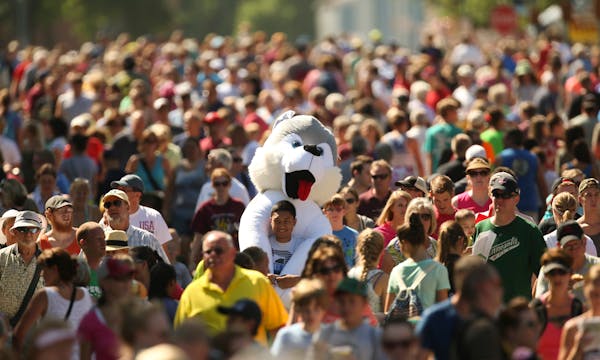What is Minnesota Nice and where did the term originate?
Listen and subscribe to our podcast: Via Apple Podcasts | Spotify | Stitcher
The term Minnesota Nice is so familiar to longtime residents that when it first appeared in this newspaper in 1986, the writer didn't bother to define it. For newcomers, however, the phrase and the complex web of behaviors it describes can be confusing.
While there's no official definition, the term typically refers to Minnesotans' tendency to be polite and friendly, yet emotionally reserved; our penchant for self-deprecation and unwillingness to draw attention to ourselves; and, most controversially, our maddening habit of substituting passive-aggressiveness for direct confrontation.
Sara Skinner, a recent transplant from North Carolina, first encountered the expression at the Children's Theatre production of "The Abominables," as an overzealous hockey mom sang about the friendly veneer masking the ruthless competition of tryouts. "I was sitting there thinking, 'What is Minnesota Nice? What are they talking about?' " she said.
Since then, she realized that she has experienced Minnesotans' particular brand of niceness. She also has tried to explain it to refugees and immigrants at the "Life in Minnesota" class she teaches at the International Institute of Minnesota in St. Paul.
Skinner posed a question about the roots of Minnesota Nice to the Star Tribune's Curious Minnesota project, which invites readers to ask questions for reporters to answer. She wondered about our shy reserve, nonstop apologizing and underpinnings of saccharine or sullen resistance. "Is it Scandinavian?" she asked.
That's one of the three theories we've pinned down. The others credit (or blame) our agrarian history or Garrison Keillor. But first, some background.
Sussing out the origins of Minnesota Nice is difficult, in part, because of the lack of consensus around its meaning. Minnesotans wearing T-shirts sporting the slogan likely see it as genuine kindness: a reputation for pushing a stranger's car out of a snowbank or refraining from honking at a terrible driver.
But to others it denotes the shadow side of nice: acting chipper even though you're mad enough to push somebody into a wood chipper.
"It can be seen in really a positive way, but also a less positive way that suggests that it's all a facade — and the facade is 'Fargo,' " said Stephen Gross, a history professor at University of Minnesota, Morris, referencing the black humor of the Minnesota-bred Coen brothers' 1996 movie.
This duality, Gross suggested, reflects a similar tension between Minnesotans' habit of portraying themselves as "liberal, gracious and hospitable" and their reputation for interpersonal aloofness.
The Scandinavian angle
One popular theory: We can thank (or blame) our Scandinavian immigrants for Minnesota Nice.
Minnesota has more residents of Scandinavian ancestry than any other state; they make up roughly 30 percent of the population.
Although German ancestry dominates, at closer to 35 percent, the state's Nordic influence has been more widely recognized. (The Scandinavians were more active in early politics, their "son"-ending surnames gave them greater visibility, and the local NFL team is named after their iconic, seafaring tough guys.)
Prof. Kari Lie Dorer, head of Norwegian language and Nordic studies at St. Olaf College in Northfield, sees a link between Minnesota Nice and the culture brought to the state by Norwegian immigrants.
Minnesota Nice attitudes resemble the "Law of Jante" described in a 1930s satirical novel by a Danish-Norwegian author that forms a code of conduct for residents of a fictional town, Lie Dorer explained in an e-mail. (Rule No. 1: Don't think that you are special.)
The rules portray Scandinavian social norms — that no one person is more important than any other, and that an individual's needs should be subordinate to those of the group.
This mentality leads to Norwegians' frequent use of the passive voice ("It would be an idea to"), which is simply considered polite. But in Minnesota, indirect language is frequently used when the speaker feels frustrated or angry. "The same words can be interpreted as having more of a passive-aggressive connotation," Lie Dorer wrote.
Rural theories
Another idea: The state's early demographics and economy let to our polite reserve.
When Minnesota was settled, geographic pockets were dominated by specific ethnic groups. Isanti and Chisago counties, north of the Twin Cities, were Swede country; Norwegians headed west to the Red River Valley; those of German ancestry established themselves in the Mississippi and Minnesota River valleys.
In this "rural ethnic mosaic," Gross explained, people of different cultures lived near one another, but didn't really intermingle. "It's a kind of reluctant pluralism — a pluralism in which boundaries are still pretty firmly put in place."
Corey Bonnema, co-author of the book "Minnesota Nice? A Transplant's Guide to Surviving and Thriving in Minnesota," pointed out that Minnesota's historically robust agrarian economy and cold, hard winters required residents to have at least cordial connections with their neighbors.
The "farmer wave" (raising a finger or two from your pickup's steering wheel) showed a reserved friendliness, but it was also a survival strategy.
"If you were trying to get your crops in at the end of the year and your plow broke, you have to get along with your neighbor because it could be a life or death issue," Bonnema said.
At the same time, since Minnesota's farmers experienced less friction with their neighbors than, say, New York City apartment dwellers, they didn't have much experience navigating interpersonal conflict, making them reluctant to engage.
Former Minneapolis Mayor R.T. Rybak, now head of the Minneapolis Foundation, has long served as something of an ambassador for the state, so he's well-versed in explaining the culture to outsiders.
After tossing out a few jokes ("Minnesotans will give you directions to anywhere but their house." "If you want to make a friend in Minnesota, go to kindergarten."), he riffed on the rural theory.
The Twin Cities area is the locus of a "talent shed" drawing people from rural areas throughout the Upper Midwest, he said. Unusual for an urban center of its size and sophistication, the metro area is made up primarily of people who are from a small town, or one or two generations removed. So city dwellers still act like country folk.
In a mega-metropolis such as New York or Shanghai, people adopt a certain level of anonymity in public spaces, where you don't acknowledge others, Rybak said.
By contrast, he described his daily rides in the IDS Tower's elevator as more like a town hall meeting. "You're really rude if you don't turn to the person next to you and at least say something about the Twins or the weather," he said.
Or maybe it's all a myth?
Finally, the dark-horse theory: Minnesota Nice is a myth, a marketing vehicle created by our cultural narrators.
Annette Atkins, professor emerita of the College of St. Benedict and St. John's University and author of "Creating Minnesota: A History From the Inside Out," suspects that the notion was generated in a "Minnesota is special" time fostered by Howard Mohr, author of 1987's "How to Talk Minnesotan," and Garrison Keillor, creator of the 1974-2016 radio show "A Prairie Home Companion."
Since there's no definitive data to substantiate Minnesotans' niceness claims, perhaps these yarn-spinners manufactured the idea to help us stand out in flyover land?
Before Mohr and Keillor became popular, Atkins said, Minnesotans differentiated themselves through corny Iowa jokes asserting their superiority over the Idiots Out Walking Around to the south.
No longer content to shrink in the shadows of taller buildings, we may have tossed the rotting "Minneapple" moniker of the 1980s and rebranded ourselves, as Keillor liked to say, "above average" and genuinely nicer (or fake nicer) than the rest.
---
If you'd like to submit a Curious Minnesota question, fill out the form below:
Read more Curious Minnesota stories:
Why isn't Isle Royale a part of Minnesota?
Why does Minnesota tax Social Security benefits?
Why is Uptown south of downtown in Minneapolis?
Why can't Minnesotans figure out how to zipper merge?
What percentage of Minnesotans spend their entire lives here?
Were Minneapolis' skyways first created to combat the cold – or something else?
Why hasn't Minnesota ever produced a U.S. president?
How did Minnesota's indigenous people survive the extreme winters?



